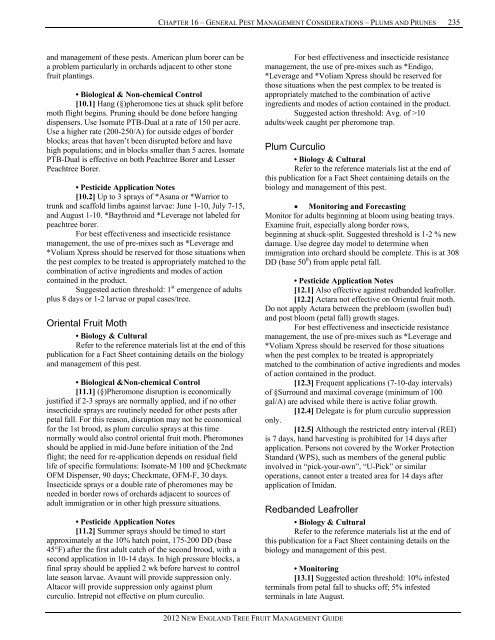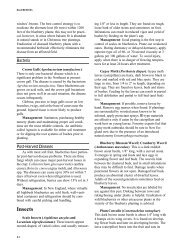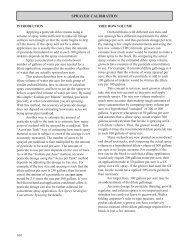Plums and Prunes
Plums and Prunes
Plums and Prunes
You also want an ePaper? Increase the reach of your titles
YUMPU automatically turns print PDFs into web optimized ePapers that Google loves.
CHAPTER 16 – GENERAL PEST MANAGEMENT CONSIDERATIONS – PLUMS AND PRUNES235<strong>and</strong> management of these pests. American plum borer can bea problem particularly in orchards adjacent to other stonefruit plantings.• Biological & Non-chemical Control[10.1] Hang (§)pheromone ties at shuck split beforemoth flight begins. Pruning should be done before hangingdispensers. Use Isomate PTB-Dual at a rate of 150 per acre.Use a higher rate (200-250/A) for outside edges of borderblocks; areas that haven’t been disrupted before <strong>and</strong> havehigh populations; <strong>and</strong> in blocks smaller than 5 acres. IsomatePTB-Dual is effective on both Peachtree Borer <strong>and</strong> LesserPeachtree Borer.• Pesticide Application Notes[10.2] Up to 3 sprays of *Asana or *Warrior totrunk <strong>and</strong> scaffold limbs against larvae: June 1-10, July 7-15,<strong>and</strong> August 1-10. *Baythroid <strong>and</strong> *Leverage not labeled forpeachtree borer.For best effectiveness <strong>and</strong> insecticide resistancemanagement, the use of pre-mixes such as *Leverage <strong>and</strong>*Voliam Xpress should be reserved for those situations whenthe pest complex to be treated is appropriately matched to thecombination of active ingredients <strong>and</strong> modes of actioncontained in the product.Suggested action threshold: 1 st emergence of adultsplus 8 days or 1-2 larvae or pupal cases/tree.Oriental Fruit Moth• Biology & CulturalRefer to the reference materials list at the end of thispublication for a Fact Sheet containing details on the biology<strong>and</strong> management of this pest.• Biological &Non-chemical Control[11.1] (§)Pheromone disruption is economicallyjustified if 2-3 sprays are normally applied, <strong>and</strong> if no otherinsecticide sprays are routinely needed for other pests afterpetal fall. For this reason, disruption may not be economicalfor the 1st brood, as plum curculio sprays at this timenormally would also control oriental fruit moth. Pheromonesshould be applied in mid-June before initiation of the 2ndflight; the need for re-application depends on residual fieldlife of specific formulations: Isomate-M 100 <strong>and</strong> §CheckmateOFM Dispenser, 90 days; Checkmate, OFM-F, 30 days.Insecticide sprays or a double rate of pheromones may beneeded in border rows of orchards adjacent to sources ofadult immigration or in other high pressure situations.• Pesticide Application Notes[11.2] Summer sprays should be timed to startapproximately at the 10% hatch point, 175-200 DD (base45°F) after the first adult catch of the second brood, with asecond application in 10-14 days. In high pressure blocks, afinal spray should be applied 2 wk before harvest to controllate season larvae. Avaunt will provide suppression only.Altacor will provide suppression only against plumcurculio. Intrepid not effective on plum curculio.For best effectiveness <strong>and</strong> insecticide resistancemanagement, the use of pre-mixes such as *Endigo,*Leverage <strong>and</strong> *Voliam Xpress should be reserved forthose situations when the pest complex to be treated isappropriately matched to the combination of activeingredients <strong>and</strong> modes of action contained in the product.Suggested action threshold: Avg. of >10adults/week caught per pheromone trap.Plum Curculio• Biology & CulturalRefer to the reference materials list at the end ofthis publication for a Fact Sheet containing details on thebiology <strong>and</strong> management of this pest. Monitoring <strong>and</strong> ForecastingMonitor for adults beginning at bloom using beating trays.Examine fruit, especially along border rows,beginning at shuck-split. Suggested threshold is 1-2 % newdamage. Use degree day model to determine whenimmigration into orchard should be complete. This is at 308DD (base 50 0 ) from apple petal fall.• Pesticide Application Notes[12.1] Also effective against redb<strong>and</strong>ed leafroller.[12.2] Actara not effective on Oriental fruit moth.Do not apply Actara between the prebloom (swollen bud)<strong>and</strong> post bloom (petal fall) growth stages.For best effectiveness <strong>and</strong> insecticide resistancemanagement, the use of pre-mixes such as *Leverage <strong>and</strong>*Voliam Xpress should be reserved for those situationswhen the pest complex to be treated is appropriatelymatched to the combination of active ingredients <strong>and</strong> modesof action contained in the product.[12.3] Frequent applications (7-10-day intervals)of §Surround <strong>and</strong> maximal coverage (minimum of 100gal/A) are advised while there is active foliar growth.[12.4] Delegate is for plum curculio suppressiononly.[12.5] Although the restricted entry interval (REI)is 7 days, h<strong>and</strong> harvesting is prohibited for 14 days afterapplication. Persons not covered by the Worker ProtectionSt<strong>and</strong>ard (WPS), such as members of the general publicinvolved in “pick-your-own”, “U-Pick” or similaroperations, cannot enter a treated area for 14 days afterapplication of Imidan.Redb<strong>and</strong>ed Leafroller• Biology & CulturalRefer to the reference materials list at the end ofthis publication for a Fact Sheet containing details on thebiology <strong>and</strong> management of this pest.• Monitoring[13.1] Suggested action threshold: 10% infestedterminals from petal fall to shucks off; 5% infestedterminals in late August.2012 NEW ENGLAND TREE FRUIT MANAGEMENT GUIDE







